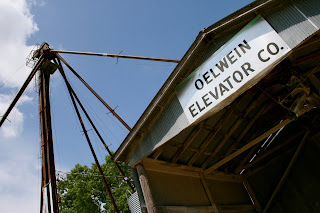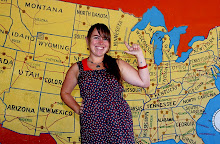
Cedar Falls, Iowa is home to my grandparents, Unc, cousins, great....yeah, you get it. Most of the fam is in Northeast Iowa. I have these vivid childhood memories that are labeled "IOWA" in my mind. From feeding my grandparents' dogs freshly-picked asparagus through the fence, to my great-grandfather's farm, to putting the tomato plants in Grandpa's garden, all my favorite memories are connected to the landscape and products of the natural environment.
One of my absolute favorite "photo study" locations is on an old farm, re-imagined as an art studio and gardens outside Fairbank, Iowa. It makes the move from "landscaped-inspired" art to art "produced within the landscape". Lyle Chase is a sculpture artist who essentially pours cement in natural molds (such as the ground) and imprints them with found natural objects.
The best part of visiting Lyle's "Country Roads" studio and shop: it's a surreal cottage-like fantasy land with plenty of mini-exhibits to encounter. I become a little kid, lost with my camera when I visit. I feel like I'm scavenging around a whimsical found-object playland of sets and props: but the Iowa farm version versus LA or NY.
Lyle also grows garden plants and succulents, all very affordably priced. I brought home about five healthy Jade and other succulents, all for about $4 each, and most varieties were rare.
This year, I also picked-up a cement-poured bird bath, which is particularly hilarious because I am terrified of birds. I couldn't help myself! Its a green-shimmery vessel pressed with leaves. I wish I could bathe in it! I put it on the side of the house to divert the birds' attention from me entering in the front (and attacking me). LOL, mostly.
The best reason for a stop by Country Roads: it's the least pretentious art space I've ever been to. It's accessible, affordable, and genuine. Lyle's low-pressure sales and encouragement to enjoy the space make seem more like your stopping by a cool uncle's farm for a visit.
When we get done at Lyle's, we cruise into Waterloo for Rudy's Tacos. Rudy's has been using a sustainable agricultural model since 1997. I don't think "locavore" had become celebrity-status-sexy at that point. Just about every ingredient at Rudy's is locally sourced, so just imagine how fresh the taste is when you've got all the summer veggies in season. In a great article I found about the impact Rudy's has on the community, here's a standout quote:"I like seeing the old men show up with their pickup trucks full of tomatoes," says Mary Twaites, an industrial engineer at the John Deere plant and a Rudy's regular. "The food is so much fresher, tastier. And if I support local farmers, then they can buy a new John Deere tractor."
The bean burrito drowned in homemade salsa, local cheese and guacamole (ok, that's probably one of the non-local delicacies in Waterloo) is my plate of choice. Great kitchy decor to match great food. Check out my Mom, Grandma and Grandpa, post-taco. Gramps and Grams are 82 years-old, so you can see how that locavore diet pays off in Iowa!
This is my last "Iowa series" post, so I wanna give a shout-out to Unc (my Uncle Jim), who works as navigator and local guide on the Iowa adventures. I couldn't find half of the places I go in Iowa without him!
























